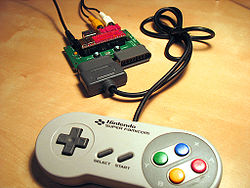Uzebox
 Uzebox with a SNES controller | |
| Type | Video game console |
|---|---|
| Storage | SD/MicroSD |
| Input | Joypad, mouse |
The Uzebox is a retro-minimalist open source video game console design. It is based on an AVR 8-bit general purpose microcontroller made by Atmel. The particularity of the system is that it uses an interrupt driven kernel and has no frame buffer. Functions such as video sync generation, tile rendering, and music mixing is done realtime by a background task so games can easily be developed in C. The design goal was to be as simple as possible yet have good enough sound and graphics while leaving enough resources to implement interesting games. Emphasis was put on making it easy and fun to assemble and program for any hobbyists. The final design contains only two chips: an ATmega644 and an AD725 RGB-to-NTSC converter.
The Uzebox was listed in Make Magazine's definitive open source hardware projects of 2009 [1].
Features

- Low parts count and cost: The system is made of only two chips and discrete components.
- Interrupt driven kernel: No cycle counting required, sound mixing and video generation are all made in the background.
- 256 simultaneous colors: Accomplished by using a R-2R resistor ladder DAC.
- 4 channels sound engine: The sound subsystem is composed of 3 wavetable channels and 1 noise or PCM channel.
- MIDI In: With a music sequencer, allows the creation of music directly on the console.
- Retro controllers: The joypad inputs uses standard NES/SNES controllers interface.
- SNES Mouse Support.
- SD/MicroSD card interface.
- Expandable: I/O lines and peripherals are still available, like the UART and SPI port for one to experiment.
- Emulator: A fully cycle-perfect, emulator greatly eases development.
- Gameloader (beta): Load and flash games stored on SD cards.
- API: Develop games using an API that provides multiple video modes, sound driver and more.
- Open Source: The software and hardware design are totally free and licensed under the GPL.
Hardware Specifications

- CPU: ATmega644 microcontroller
- Total RAM: 4K
- Program Memory: 64K
- Speed: 28.61818Mhz (Overclocked)
- Colors: 256 simultaneous colors arranged in a 3:3:2 color space (Red:3 bits, Green:3 bits, Blue: 2 bits)
- Video output: NTSC Composite and S-Video
- Sound: 8-bit mono, mixed at ~15Khz and output via PWM
- Inputs: Two NES/SNES compatible joypad inputs
- External storage: SD/MicroSD
- Options: MIDI-in interface
Implementations
As of 2010, the Uzebox design has been commercially implemented by the Uzebox AVCore, a fully assembled unit and the Fuzebox[2][3], a Do-It-Yourself kit.
See also
References
- ^ Fun, games and entertainment: Open source hardware 2009 Make:Online: The definitive guide to open source hardware projects in 2009
- ^ Fuzebox at Make:Online Blog
- ^ http://technabob.com/blog/2009/03/11/fuzebox-8-bit-gaming-goes-open-source/
